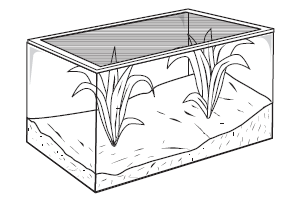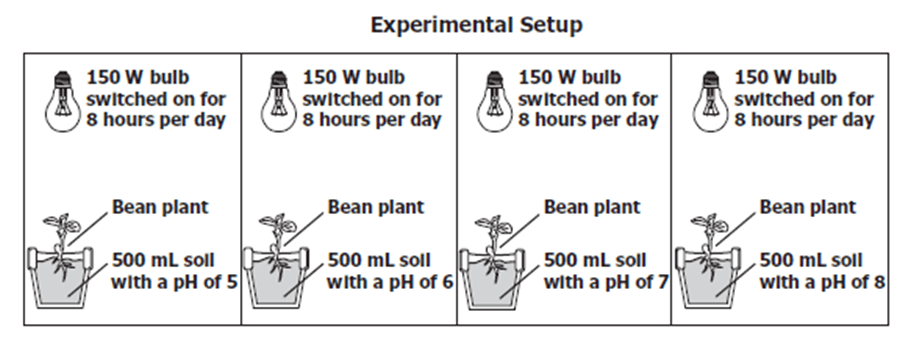Which of these statements is NOT an observation?
A) the insect has 3 legs on the left side
B) the insect has a pattern on its back
C) The insect's pattern shows that it is poisonous
D) The insect is green, white, and black
C
Identify the independent variable.

Temperature (degrees Celsius)
A tentative explanation that can be supported, modified, or rejected based on collected data. It can be tested by further investigation.
Hypothesis
Describe the difference between multicellular and unicellular, and give an example of each type of organism.
Multicellular - made of many cells (like plants or animals)
Unicellular - made of only one cell (like bacteria or amoebas)
Describe the difference between a population and a community.
A population is a group of the SAME species in an area, a community if a group of DIFFERENT species living in an area.
Which type of lab equipment is used to measure mass, and what unit of mass is used in the metric system?
Electronic balance (g)
A student hypothesizes that green algae will grow fastest when exposed to blue light. To test this hypothesis, the student should design an experiment with which dependent variable?
A) color of algae
B) rate of algae growth
C) color of light
D) amount of time per day that light is turned on
B) rate of algae growth
A statement that is an accepted explanation of a large body of information; it is subject to change as new evidence becomes available.
Theory
This word means to maintain a stable internal environment.
Homeostasis
Organize the following levels from smallest to largest:
cell, organelle, atom, organ, molecule, tissue, organ system
Atom --> molecule --> organelle --> cell --> tissue --> organ --> organ system
A student constructs several terrariums like this one. Each terrarium is exposed to a different amount of sunlight each day. In order to determine the ideal amount of sunlight, which of the following variables must be held constant?
A) Type of plants
B) Growth rate of plants
C) Amount of sunlight received
D) Wavelengths of sunlight
A) Type of plants
Identify the mean, median, mode, and range for the following data set:
2, 7, 4, 3, 10, 3, 2, 1
Mean: 4
Median: 3
Mode: 2 and 3
Range: 9
A statement of fact that is generally accepted to be true and universal.
law
Identify and describe the two ways that organisms can obtain energy.
Autotrophs make their own sugar; heterotrophs consume or break down other organisms to get energy.
Put the following levels in order from smallest to greatest:
cell; biome; organism; molecule; organ; community
molecule --> cell --> organ --> organism --> community --> biome
Students in a a biology class thought that salt water would affect the movements of planaria. They put 25 planaria in salt water and recorded their observations. Which flaw was present in the design of their experiment?
A) There was no hypothesis
B) There was no control
C) The sample was too big
D) The procedure was too complicated
B) There was no control

Identify the independent variable of the experiment.
Sol pH
Students in a biology class thought that salt water would affect the movements of planaria. They put 25 planaria in salt water and recorded their observations. They flaw in this experiment is that
A) there is no hypothesis
B) there is no control
C) the sample is too big
D) the procedure is to complicated
B) there is no control (they should also have 25 planaria in just water with NO salt)
Describe a difference between sexual and asexual reproduction.
Sexual = 2 parent cells combining their genetic information; the offspring is genetically unique
Asexual = 1 parent cell making copies of itself; the offspring are identical
List the organizational levels in order from organism to biosphere.
organism --> population --> community --> ecosystem --> biome --> biosphere
List the 6 steps of the scientific method in order.
1) Identify a problem/ask a question
2) Research and make observations/inferences
3) Hypothesis
4) Experiment and collect data
5) Anayze data
6) Communicate results
For the following hypothesis, identify the:
- IV, DV, 2 constants, control group, experimental groups
If we increase the amount of light during studying, then the participant's score will decrease.
IV: amount of light
DV: score
constants: same amount of time to study, same age and GPA of participants, same test
Control group: participants who get the normal amount of light
Experimental groups: participants who get more light

What is the mean number of bacteria between 9-1 PM?
4
List 6 of the 8 characteristics of life.
- made of cells
- uses DNA and RNA as genetic instructions
- maintains homeostasis
- obtains and uses energy
- grows and develops
- able to reproduce
- responds to a stimulus
- as a population, evolves
The biome that we in Virginia live in.
What is a temperate deciduous forest?